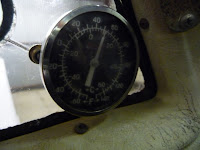Yesterday I flew 76Q up to Fort Worth's Meacham Field, AKA Forth Worth Meacham International AKA KFTW from Beaumont (KBPT). I went up there to have my propeller checked in accordance with AD (Airworthiness Directive) 2009-22-03. The AD is an order from the FAA that must be complied with in order for a plane; i.e., one that falls under the AD, to remain airworthy. Not all Mooney's have this kind of propeller and those that don't will use that fact as a selling point.
The AD says that if you have a
Hartzell propeller model in the ()HC-()2Y()-() series, then you need to have it's hub inspected by a mechanic who is certified to use an eddy current instrument to see if you have any subsurface cracks--the test is called an Eddy Current Inspection (ECI) and has to be done after every 100 hours of flying. It used to be that or every year, whichever came first. This recent AD relaxed the requirement by dropping the "every year" to accommodate the hangar queens that don't get flown much.
The prop hub is the part that holds the blades. On a fixed blade propeller, it is just the circular center section with the holes in it to mount it to the engine. On a constant speed prop, like 76Q has, the hub is a complicated unit that the two blades, which rotate on an axis perpendicular to the propeller axle, are mounted to. The hub must withstand significant forces and so is a potential failure point.

The image to the left shows the mechanic doing the ECI on my plane. He is holding the instrument probe in his right hand and touching it to various places on the hub. To get at the hub, he had to remove the spinner. His left hand is resting on one of the propeller blades.
The hub was fine and I learned a good deal from the A&P who did the check about hubs and propellers. Apparently, only two of these particular hubs have ever failed, both offshore, I believe he said the UK, and under questionable circumstance; i.e., other factors may have caused the crashes. He said he has never seen a cracked hub in all of the ECI's he has done. His instrument has been well used and I noted that it is just an X-Y o'scope with a signal generator.
Every time an AD is issued on a GA aircraft it is generally accompanied by an uproar, the magnitude of which is proportional to the costs involved in complying with the AD. This inspection is no different and the new change will be viewed with great relief by many owners of airplanes since they will no longer have to have this check done yearly. A plane can go for years without this inspection as long as it isn't flown--but then you have to ask, why own a plane?
As to the flight, it was easy. I flew direct to DARTZ, an enroute fix along VFR flyway V239. I chose DARTZ because it was well clear of the DFW Class B airspace. It was a good thing that I flew there first because ATC was specific in telling me to stay clear of the class bravo. I thought that was a bit rude, but it turns out that the FAA is very cautious about letting VFR flights into Class B airspace. When I left FTW, they cleared me into the bravo immediately and I flew away through it. My guess is that if you are leaving, then you are a lesser threat.
Some pilots avoid a Class B like the plague. I personally think it is sort of neat to be listening to the radio and hearing Continental two-zero-five-one climb to flight level three-two-zero or Southwest one-zero-seven turn left heading zero-two-four. You know you are flying with the big boys (girls too!) when you hear those sorts of things on the frequency you have been assigned. When I hear Mooney five-niner-seven-six-quebec I know that the jet jockeys are hearing it too and wishing they were buzzing around in a sports car instead of steering an (air) bus around full of passengers.
It took me three hours to fly up and one to fly back. I took my time going up, had a bit of turbulence and headwind as well as the indirect route via DARTZ. On the way back, I flew a direct return course with a tail wind and let all the stops out. My Garmin clocked me at 212 MPH max ground speed. This is essentially why guys fly Mooneys. For the amount of money invested, you cannot buy a faster plane, period. In fact, the plane is so slippery that it is hard to slow down.







